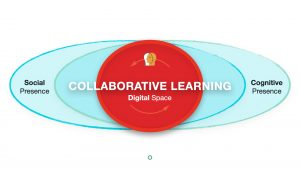Overview
Building Collaborative Learning Communities
Collaborative learning may fall within the subset of active learning and can involve several students sharing an equitable workload and challenges, supporting each other and working together in sync to achieve the desired learning outcomes. This collaboration stimulates engagement in active learning and fosters community among students who might otherwise feel disengaged and disconnected in the anonymity of the online environment (Barkley et al., 2014). In a collaborative learning setting, students discover and inculcate team-building skills together, support each other academically and socially (Lai, 2015), and develop a sense of belonging (Berry, 2017). By working towards a shared learning goal (Adams & Wilson, 2020), students can prepare themselves for success.
Making Collaborative Learning Work
Three important aspects that make collaborative learning work (Johnson et al., 2014) are:
- the ability to promote cordial relationships;
- the connection to skill development;
- the ability to help develop a positive attitude towards learning and teaching.
Successful collaborative learning is entwined with inclusivity that thrives on mutual trust and respect. Community building is about planning and creating a positive learning space by applying deliberate pedagogical choices. Students and instructors work together towards a shared learning goal through meaningful social interactions (Dolan et al., 2019; Berry, 2019).
Collaborative and community-building approaches are an integral part of online education practice. Yet, many of us may still find it challenging to instill a collaborative culture in our classroom that promotes the three thrusts mentioned. Promoting all three are paramount for success in the corporate world and in life, in general.
Demonstrating an ability to collaborate effectively is a critical aspect for students who are making the transition to the workplace (Stephens & Roberts,2017). We will explore how successful instructors have been able to foster a culture of collaborative communities, and we’ll highlight some strategies for effective collaborative learning. You will also be able to learn about some of the activities that may direct you to harness the power of social interactions for more purposeful learning.
Learning Objectives
After exploring this module, you will be able to:
- Identify the key concepts of collaborative learning and student community building;
- Plan innovative and effective collaborative activities that promote higher-level thinking;
- Apply specific strategies to create an environment of respect and gratitude that enables students to reach a higher potential.
The Essence of Collaborative Learning Communities
The Fully Online Learning Community model (FOLC) (vanOosteen et al., 2016), represents an offshoot of the Community of Inquiry (CoI) model (Garrison, 2011) as discussed earlier.

FOLC incorporates only social presence (SP) and cognitive presence (CP) from the CoI model, as it acknowledges Teaching presence within Social Presence (SP) and Cognitive Presence (CP), thus placing more importance on communities and learner empowerment. It also introduces “digital space” as another construct that subsumes synchronous and asynchronous interventions. Successful collaborative learning is achieved at the intersection of these three dimensions, where students develop a sense of community and apply the digital affordances to build up their cognitive and critical thinking skills.

